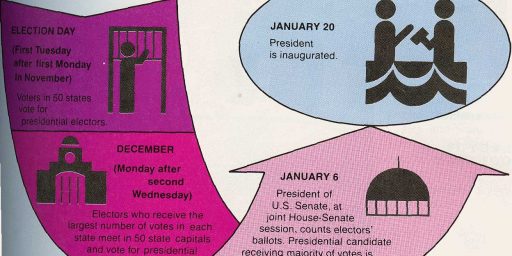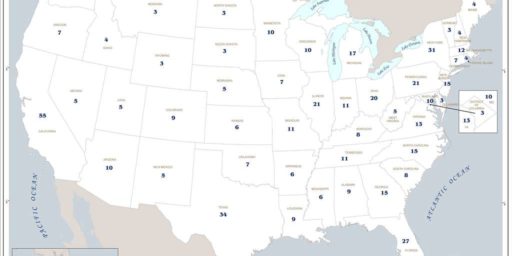California to Divide Electoral Votes?
Good Luck Getting That Knife Near Electoral Pie (LAT)
Assemblyman Tom Harman is the first to admit that his bill to toss out California’s winner-take-all allotment of presidential electoral votes has a snowball’s chance in Needles of making it out of the Legislature. “To quote John Burton, the chances are slim and none, and slim just left town,” said Harman (R-Huntington Beach), referring to the newly termed-out Senate president pro tem. So why lunge headlong into sure defeat? Harman, who co-wrote the bill with Assemblyman John Benoit (R-Palm Desert), believes that just discussing the apportionment of electoral votes by congressional district may capture the public’s imagination. And that, he hopes, could lead to a ballot initiative to force the change before the 2008 presidential campaign.
Only two states — Maine and Nebraska — divide up their electoral votes by congressional district. Colorado voters last month rejected a proposal to split that state’s nine electoral votes by the percentage of popular vote each candidate wins.
If California’s 55 electoral votes were in play, rather than assumed to be won by the Democratic candidate, it would ensure that the candidates paid proper attention to the nation’s most populous state, Harman said. If Harman’s system had been in place Nov. 2, California would have delivered 35 electoral votes to Sen. John F. Kerry (for winning the vote in 33 House districts plus two votes for being the statewide winner) and 20 to President Bush. “That’s the same number of votes Bush got in Ohio,” Harman said. “The campaigns used California as an ATM machine to carry on their campaigns elsewhere.”
While going to a proportional method would have been political suicide for Colorado, it makes some sense in the case of California. Unless there is a dramatic realignment, the Golden State is in the Democratic camp for the long haul, meaning Democrats take it for granted and Republicans ignore it. Under a proportional system, President Bush would likely have campaigned there much more vigorously, since even a few percentage points in California would be worth more than many of the smaller states.
Of course, the major downside for this would be that the Democrats would instantly be much, much weaker at the presidential levels. Giving the Republican candidate 15-25 of California’s 55 Electors would amount to a 30-50 point swing in the Electoral College. While this wouldn’t have made any difference in the outcomes in any recent election, it would have rendered last two elections relative GOP blowouts–making the Florida fiasco of 2000 and the wait for Kerry’s concession in 2004 unnecessary.
(via BoiFromTroy)






I’ve thought the same thing, but now I believe the result would be that more intensive campaigning would only shift the electoral vote count by a few votes. It may not be worth it given that the candidate who would have lost the all the votes will likely get a signficant chunk of the votes. The big problem with proportional or district based voting is that if the electoral vote count is close, any state with proportional voting or district in a state with district based voting is going to be a target for a recount and other post-election legal tactics.